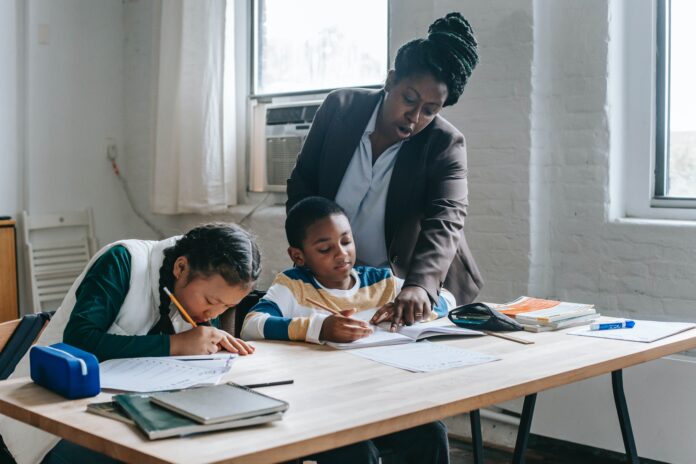
Every school year comes with different challenges, needs, and priorities.
But one thing that doesn’t seem to change is how, every fall, teachers ritualistically empty their pocketbooks, purchasing materials America fails to provide its students.
Thanks to squeezed budgets due to inadequate state and local funding, educators end up spending an average of $687 per year out of pocket. They also use platforms like DonorsChoose, where the public can help out with purchasing materials, thus easing the financial burden on teachers — whose paychecks are too small to begin with.
This year, Black teachers are specifically requesting classroom materials focused on literacy and language, STEM, and life skills, according to data from DonorsChoose. Their requests are also prioritizing students with disabilities, and items for health, sports, and wellness.
If you’re looking to help Black educators stock their classrooms and help meet their students’ needs, #BlackListCleared crowdsources wish lists for Black teachers. As their bio says, “We’re rooting for everybody Black, but especially Black educators.”
These are the top needs of Black teachers for the 2023-2024 school year.
Instructional Technology
Instructional technology is the top request among Black teachers, with 1,666 teachers requesting these materials. This ranges from music players and headphones, to printers and projectors, to calculators and software.
For example, on her donation request page, Ms. Hill, an elementary school teacher in Chicago, shared that she needs headphones for each of her third- through fifth-grade students.
“The individual headphones will be used as they work independently on their assigned digital assignments that read aloud to them,” Hill wrote on the project page. “The headphones will also assist when they are working in a small group but need to answer or read the materials independently.”
And in Mississippi, high school teacher Mrs. Banks wants visual aids to help her students stay motivated and plan for their futures. She’s looking for a photo printer, photo paper, ID badges, and cardstock to “see the vision and create a better outcome,” she wrote on the project page. “These donations will give them a purpose and a physical vision.”
Classroom Basics
Classroom basics are a close second, with 1,618 teachers requesting items from paper, writing utensils, dry erase boards, index cards, stickers, and posters.
Though these might seem like small contributions — or inexpensive things teachers can supply themselves — kids go through them like crazy, and they can really add up.
Kayla Gamble, a fourth-grade teacher in Atlanta, says pencils, glue sticks, and markers are “staples” in her classroom.
“Those things get demolished pretty quickly. Erasers get demolished very quickly,” Gamble says. “I try to remind parents to stock up in the beginning of the year because your kids are not as responsible as you think.”
Food, Clothing, and Hygiene
In a close third, 1,606 teachers asked for things falling under food, clothing, and hygiene. This includes snacks, clothing, first aid kits, deodorant, tissues, and cleaning supplies.
While Gamble tries to provide snacks twice a week for her students, it’s another item she asks parents to contribute.
“I really feel like snacks should be a requirement in school,” Gamble says. “They’re using their brains, they’re using up all their energy, they’re moving their bodies during recess, all those things, so you’re gonna get hungry in the middle of the day.”
Kimberly Christian Johnson, a 25-year educator and 2022 Alabama State Teacher of the Year, keeps all kinds of supplies in her classroom — like ramen noodles and travel-size deodorant — for students who might need a quick fix or necessities they don’t have at home.
“You just don’t know what kind of pressure and what kind of stuff they’re dealing with,” Johnson says.
Flexible Seating
There were big bumps in requests for flexible seating as teachers returned to the classroom following the virtual learning years. And that’s still in the top five requests for Black teachers, with 1,508 teachers requesting items like exercise balls, bean bag chairs, stools, sofas, and yoga mats.
Flexible seating allows students to move more freely around the classroom, which can help with any social or emotional trauma, hyperactivity, or other needs they might have.
Dallas-area art teacher Ms. Spurlock explained that flexible seating in her classroom will both increase students’ comfort while learning and give them more options based on their individual needs.
“This will designate a space to further develop social awareness and build camaraderie art dialogue,” she wrote on her project page. “The more we come together, the more we grow together. It is my goal to create a space where my students can come to learn, exhale, and excel.”
Educational Kits and Games
Though it may not sound like a priority, educational kits and games provide a lot of enrichment to students. They can be anything from flash cards to puzzles to model building kits.
In Maryland, Ms. Nzengung teaches students with individual education plans, and she is anticipating having more students with autism and ADHD this school year. To help meet their individual learning needs, Nzengung wants to incorporate more sensory-based literacy and mathematics activities.
“I’m trying my very best to make sure that my oncoming scholars have everything that they need to be successful throughout their academic journey,” she wrote on the project page.
Ms. Patterson, a Maryland middle school teacher, is looking for a host of educational board games that will help her students “not only learn history but truly engage with and retain that knowledge.” Some of the games she’s requesting include Herstory: The Board Game of Remarkable Women, America-opoly, and Scholastic Race Across the USA.
Patterson teaches a “diverse range of learners,” from general education to special education to English language learners.
“Ultimately, the combination of resources provides our students with a dynamic and engaging learning experience,” Patterson wrote on the project page. “With these tools, we are able to tailor our teaching approach to each individual student, ensuring they have the support they need to succeed.”


